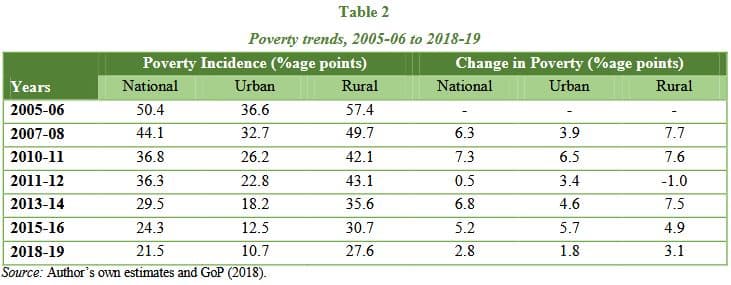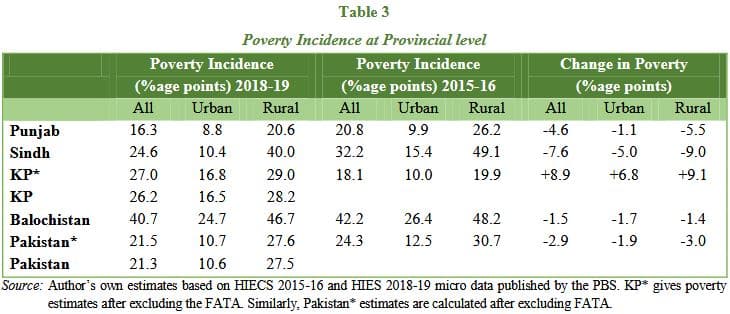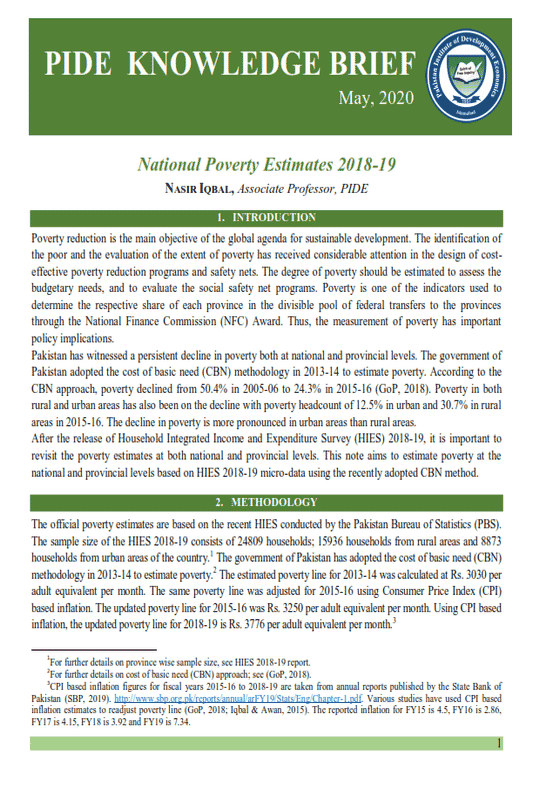National Poverty Estimates 2018 19
National Poverty Estimates 2018-19
Nasir Iqbal, Associate Professor, PIDE
-
INTRODUCTION
Poverty reduction is the main objective of the global agenda for sustainable development. The identification of the poor and the evaluation of the extent of poverty has received considerable attention in the design of cost-effective poverty reduction programs and safety nets. The degree of poverty should be estimated to assess the budgetary needs, and to evaluate the social safety net programs. Poverty is one of the indicators used to determine the respective share of each province in the divisible pool of federal transfers to the provinces through the National Finance Commission (NFC) Award. Thus, the measurement of poverty has important policy implications.
Pakistan has witnessed a persistent decline in poverty both at national and provincial levels. The government of Pakistan adopted the cost of basic need (CBN) methodology in 2013-14 to estimate poverty. According to the CBN approach, poverty declined from 50.4% in 2005-06 to 24.3% in 2015-16 (GoP, 2018). Poverty in both rural and urban areas has also been on the decline with poverty headcount of 12.5% in urban and 30.7% in rural areas in 2015-16. The decline in poverty is more pronounced in urban areas than rural areas.
After the release of Household Integrated Income and Expenditure Survey (HIES) 2018-19, it is important to revisit the poverty estimates at both national and provincial levels. This note aims to estimate poverty at the national and provincial levels based on HIES 2018-19 micro-data using the recently adopted CBN method.
-
METHODOLOGY
The official poverty estimates are based on the recent HIES conducted by the Pakistan Bureau of Statistics (PBS). The sample size of the HIES 2018-19 consists of 24809 households; 15936 households from rural areas and 8873 households from urban areas of the country.[1] The government of Pakistan has adopted the cost of basic need (CBN) methodology in 2013-14 to estimate poverty.[2] The estimated poverty line for 2013-14 was calculated at Rs. 3030 per adult equivalent per month. The same poverty line was adjusted for 2015-16 using Consumer Price Index (CPI) based inflation. The updated poverty line for 2015-16 was Rs. 3250 per adult equivalent per month. Using CPI based inflation, the updated poverty line for 2018-19 is Rs. 3776 per adult equivalent per month.[3]
The updated poverty line was applied on the aggregate consumption expenditure obtained from the HIES 2018-19 micro-data to estimate poverty levels. The consumption aggregate has three main components:
- (i) aggregate nominal consumption expenditure: which includes all food and non-food expenditures of the household converted into the same time unit, for instance annual, monthly or weekly expenditures
- (ii) spatial price index: to adjust for the cost of living differences across space or regions
- (iii) equivalence scale: to adjust for differences in household size and age composition across households.
The consumption aggregate includes all food and non-food expenditures that are incurred on a recurrent basis. Expenditures on durable goods are not included in the consumption aggregate. For the spatial price index, we use Passche formula and is estimated at the level of a primary sampling unit (PSU). Pakistan uses a basic adult equivalence scale which assigns a weight of 0.8 to each individual below the age of 18, and a weight of 1 to each individual age 18 and above. The final welfare aggregate used for poverty measurement in Pakistan is the spatially adjusted monthly per-adult equivalent consumption expenditure.
________________________
[1]For further details on province wise sample size, see HIES 2018-19 report.
[2]For further details on cost of basic need (CBN) approach; see (GoP, 2018).
[3]CPI based inflation figures for fiscal years 2015-16 to 2018-19 are taken from annual reports published by the State Bank of Pakistan (SBP, 2019). http://www.sbp.org.pk/reports/annual/arFY19/Stats/Eng/Chapter-1.pdf. Various studies have used CPI based inflation estimates to readjust poverty line (GoP, 2018; Iqbal & Awan, 2015). The reported inflation for FY15 is 4.5, FY16 is 2.86, FY17 is 4.15, FY18 is 3.92 and FY19 is 7.34.
-
POVERTY ESTIMATES: MAGNITUDE AND TRENDS
Table 1 presents poverty estimates at the national level as well as for the rural and urban areas for the 2018-19 period based on the CBN method. For comparison, the corresponding estimates for the previous survey year 2015-16 are also given in this table. The estimates show that around 21.5% of people live below poverty line in 2018-19 in Pakistan. Around 10.7% population live below the poverty line in urban and over 27.6% in the rural areas in 2018-19. Overall poverty declined by 2.8% from 24.3% in 2015-16 to 21.5% in 2018-19. The decline in poverty in urban areas is 1.8% while that in the rural areas is 3.1% (Table 1).
 Over the last decade Pakistan’s poverty headcount has witnessed a persistent decline both at the national and regional levels. Table 2 presents poverty estimates since 2005-06. Proportion of people living below poverty line has declined from 50.4% in 2005-06 to 22.5% in 2018-19. Poverty in both rural and urban areas show a declining trend.
Over the last decade Pakistan’s poverty headcount has witnessed a persistent decline both at the national and regional levels. Table 2 presents poverty estimates since 2005-06. Proportion of people living below poverty line has declined from 50.4% in 2005-06 to 22.5% in 2018-19. Poverty in both rural and urban areas show a declining trend.
 The provincial estimates are given in Table 3. Punjab is the least poor province (16.3%) while Balochistan is the poorest province (40.7%) in Pakistan. Poverty has declined in all provinces except KP where it increases from 18.1% in 2015-16 to 27% in 2018-19 (an increase of 8.9 percentage point). It reflects a significant downward movement of vulnerable in KPK.
The provincial estimates are given in Table 3. Punjab is the least poor province (16.3%) while Balochistan is the poorest province (40.7%) in Pakistan. Poverty has declined in all provinces except KP where it increases from 18.1% in 2015-16 to 27% in 2018-19 (an increase of 8.9 percentage point). It reflects a significant downward movement of vulnerable in KPK.

4. BANDS OF POVERTY
The poverty profile in terms of poverty bands is very insightful for policy formulation as it groups the population into different bands which need different policy initiatives. The poverty bands given in the Table 4 below show that almost 5.5% of population falls in the category of extreme and ultra-poor. On the other hand, 16% poor are the border line cases while almost 20% is vulnerably placed.


REFERENCES
Iqbal, N. and M. S. Awan (2015) Determinants of Urban Poverty: The Case of Medium Sized City in Pakistan. The Pakistan Development Review 54:4, 719–737.
Pakistan, Government of (2018) National Poverty Report 2015-16. Islamabad: Planning Commission, Government of Pakistan.
State Bank of Pakistan (SBP) (2019) Annual Report 2018-2019 (State of the Economy). Karachi: State Bank of Pakistan.




